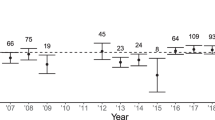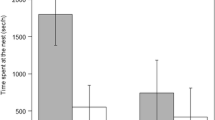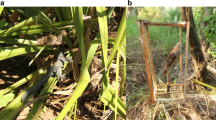Abstract
Knowledge of the investment rules adopted by breeders and non-breeders, and the factors that affect them, is essential to understanding cooperative breeding as part of a life-history tactic. Although the factors that affect relative contributions to care of young have been studied in some cooperative bird species, there is little data on mammals, making coherent generalisations within mammals and across taxa difficult. In this study, we investigate individual contributions to pup escorting, a strong predictor of offspring provisioning, in the banded mongoose (Mungos mungo), a cooperatively breeding mammal in which reproductive skew is low. Contributions by those under a year old (which virtually never breed) increased with age and body weight but were generally low. Among older age classes (yearlings and adults), individuals that had not bred in the current litter generally contributed less to escorting than those that had bred (with the exception of yearling males). In addition, females that did not breed reduced their investment if they were heavy presumably because such females are more likely to breed in the following event and benefit from saving resources for this. The generally greater contributions by breeders in banded mongooses contrast with the recent findings in meerkats (Suricata suricatta), another obligatorily cooperative mongoose with similar group size but wherein reproductive skew is high. Our results suggest that relative contributions by breeders vs non-breeders are not dependent on group size but on the ratio of breeders to carers and the probability that non-breeders will breed in the near future.



Similar content being viewed by others
References
ASAB (1991) Guidelines for the use of animals in research. Anim Behav 41:183–186
Bourke AFG (1999) Colony size, social complexity and reproductive conflict in social insects. J Evol Biol 12:245–257
Brown JL (1987) Helping and communal breeding in birds. Princeton University Press, Princeton, New Jersey
Cant MA (1998) Communal breeding in banded mongooses and the theory of reproductive skew. PhD dissertation. University of Cambridge, Cambridge, United Kingdom
Cant MA (2000) Social control of reproduction in banded mongooses. Anim Behav 59:147–158
Cant MA (2003) Patterns of helping effort in co-operatively breeding banded mongooses (Mungos mungo). J Zool 259:115–121
Cant MA, Field J (2001) Helping effort and future fitness in cooperative animal societies. Proc R Soc Lond B Biol Sci 268:1959–1964
Cant MA, Otali E, Mwanguhya F (2001) Eviction and dispersal in co-operatively breeding banded mongooses (Mungos mungo). J Zool 254:155–162
Clutton-Brock TH, Brotherton PNM, Russell AF, O’Riain MJ, Gaynor D, Kansky R, Griffin A, Manser M, Sharpe L, McIlrath GM, Small T, Moss A, Monfort S (2001) Cooperation, control, and concession in meerkat groups. Science 291:478–481
Clutton-Brock TH, Russell AF, Sharpe LL, Young AJ, Balmforth Z, McIlrath GM (2002) Evolution and development of sex differences in cooperative behavior in meerkats. Science 297:253–256
Clutton-Brock TH, Russell AF, Sharpe LL (2003) Meerkat helpers do not specialize in particular activities. Anim Behav 66:531–540
Clutton-Brock TH, Russell AF, Sharpe LL (2004) Behavioural tactics of breeders in cooperative meerkats. Anim Behav 68:1029–1040
Clutton-Brock TH, Hodge SJ, Spong G, Russell AF, Jordan NR, Bennett NC, Sharpe LL, Manser MB (2006) Intrasexual competition and sexual selection in mammals. Nature 444:1065–1068
Cockburn A (1998) Evolution of helping behavior in cooperatively breeding birds. Ann Rev Ecolog Syst 29:141–177
Davies NB, Hatchwell BJ, Robson T, Burke T (1992) Paternity and parental effort in dunnocks Prunella modularis—how good are male chick feeding rules. Anim Behav 43:729–745
De Luca DW, Ginsberg JR (2001) Dominance, reproduction and survival in banded mongooses: towards an egalitarian social system? Anim Behav 61:17–30
Elston DA (1998) Estimation of denominator degrees of freedom of F-distributions for assessing Wald statistics for fixed-effect factors in unbalanced mixed models. Biometrics 54:1085–1096
Gilchrist JS (2001) Reproduction and pup care in the communal breeding banded mongoose. PhD dissertation. University of Cambridge, Cambridge, United Kingdom
Gilchrist JS (2004) Pup escorting in the communal breeding banded mongoose: behavior, benefits, and maintenance. Behav Ecol 15:952–960
Gilchrist JS (2006) Reproductive success in a low skew, communal breeding mammal: the banded mongoose, Mungos mungo. Behav Ecol Sociobiol 60:854–863
Gilchrist JS, Otali E (2002) The effects of refuse-feeding on home-range use, group size, and intergroup encounters in the banded mongoose. Can J Zool-Revue Canadienne De Zoologie 80:1795–1802
Gilchrist JS, Otali E, Mwanguhya F (2004) Why breed communally? Factors affecting fecundity in a communal breeding mammal: the banded mongoose (Mungos mungo). Behav Ecol Sociobiol 57:119–131
Gittleman JL, Thompson SD (1988) Energy allocation in mammalian reproduction. Am Zool 28:863–875
Hatchwell BJ (1999) Investment strategies of breeders in avian cooperative breeding systems. Am Nat 154:205–219
Haydock J, Koenig WD, Stanback MT (2001) Shared parentage and incest avoidance in the cooperatively breeding acorn woodpecker. Mol Ecol 10:1515–1525
Heinsohn RG (2004) Parental care, load lightening, and costs. In: Koenig WD, Dickinson JL (eds) Ecology and evolution of cooperative breeding in birds. Cambridge University Press, Cambridge, United Kingdom, pp 67–80
Heinsohn R, Legge S (1999) The cost of helping. Trends Ecol Evol 14:53–57
Hodge SJ (2003) The evolution of cooperation in the communal breeding banded mongoose. PhD dissertation. University of Cambridge, Cambridge, United Kingdom
Hodge SJ (2005) Helpers benefit offspring in both the short and long-term in the cooperatively breeding banded mongoose. Proc R Soc Lond B Biol Sci 272:2479–2484
Kruuk LEB, Clutton-Brock TH, Albon SD, Pemberton JM, Guinness FE (1999) Population density affects sex ratio variation in red deer. Nature 399:459–461
Lacey EA, Sherman PW (1991) Social organisation of naked mole rat colonies: evidence for divisions of labour. In: Sherman PW, Jarvis JUM, Alexander RD (eds) The biology of the naked mole rat. Princeton University Press, Princeton, New Jersey, pp 275–336
Lock JM (1977) The vegetation of Rwenzori National Park, Uganda. Bot Jahrb Syst Pflanzengesch Pflanzengeogr 98:372–448
MacColl ADC, Hatchwell BJ (2003) Sharing of caring: nestling provisioning behaviour of long-tailed tit, Aegithalos caudatus, parents and helpers. Anim Behav 66:955–964
O’Riain MJ, Jarvis JUM, Alexander R, Buffenstein R, Peeters C (2000) Morphological castes in a vertebrate. Proc Natl Acad Sci USA 97:13194–13197
Otali E, Gilchrist JS (2004) Effects of refuse feeding on body condition, reproduction and survival of banded mongooses. J Mammal 85:491–497
Rood JP (1974) Banded mongoose males guard young. Nature 248:176–177
Russell AF (2004) Mammals: comparisons and contrasts. In: Koenig WD, Dickinson JL (eds) Ecology and evolution of cooperative breeding in birds. Cambridge University Press, Cambridge, United Kingdom
Russell AF, Sharpe LL, Brotherton PNM, Clutton-Brock TH (2003) Cost minimization by helpers in cooperative vertebrates. Proc Natl Acad Sci USA 100:3333–3338
Russell AF, Carlson AA, McIlrath GM, Jordan NR, Clutton-Brock T (2004) Adaptive size modification by dominant female meerkats. Evolution 58:1600–1607
Schall R (1991) Estimation of generalised linear models with random effects. Biometrika 78:719–727
Sokal RR, Rohlf FJ (1995) Biometry: the principles and practice of statistics in biological research, 3rd edn. Freeman, New York
Wilson EO (1971) The insect societies. Belknap Press, Cambridge, MA
Wright J, Dingemanse NJ (1999) Parents and helpers compensate for experimental changes in the provisioning effort of others in the Arabian babbler. Anim Behav 58:345–350
Acknowledgements
We are grateful to the Uganda Wildlife Authority for allowing JSG to conduct research in Queen Elizabeth National Park, and to Francis Mwanguhya and Emily Otali for providing invaluable assistance with data collection. We thank the following for their advice and/or comments on the manuscript: Tim Clutton-Brock, Mike Cant, Sarah Hodge, Ruth Waldick and the reviewers. For the financial support, JSG thanks the Biotechnology and Biological Sciences Research Council, Ian Karten Charitable Trust, Cambridge Philosophical Society, Magdalene College, Board of Graduate Studies, and the Department of Zoology (all at Cambridge), whilst AFR thanks the Royal Society, UK.
Author information
Authors and Affiliations
Corresponding author
Additional information
Communicated by F. Trillmich
Rights and permissions
About this article
Cite this article
Gilchrist, J.S., Russell, A.F. Who cares? Individual contributions to pup care by breeders vs non-breeders in the cooperatively breeding banded mongoose (Mungos mungo). Behav Ecol Sociobiol 61, 1053–1060 (2007). https://doi.org/10.1007/s00265-006-0338-2
Received:
Revised:
Accepted:
Published:
Issue Date:
DOI: https://doi.org/10.1007/s00265-006-0338-2




